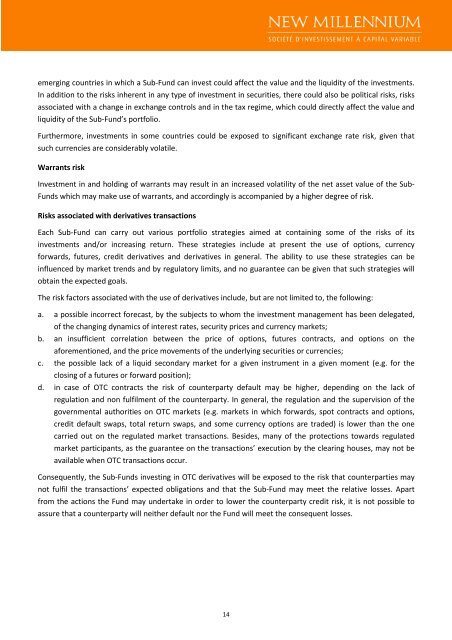PC NMS October 2012 clean version CSSF 3010 pour VISA FINAL
PC NMS October 2012 clean version CSSF 3010 pour VISA FINAL
PC NMS October 2012 clean version CSSF 3010 pour VISA FINAL
You also want an ePaper? Increase the reach of your titles
YUMPU automatically turns print PDFs into web optimized ePapers that Google loves.
emerging countries in which a Sub-Fund can invest could affect the value and the liquidity of the investments.<br />
In addition to the risks inherent in any type of investment in securities, there could also be political risks, risks<br />
associated with a change in exchange controls and in the tax regime, which could directly affect the value and<br />
liquidity of the Sub-Fund’s portfolio.<br />
Furthermore, investments in some countries could be exposed to significant exchange rate risk, given that<br />
such currencies are considerably volatile.<br />
Warrants risk<br />
Investment in and holding of warrants may result in an increased volatility of the net asset value of the Sub-<br />
Funds which may make use of warrants, and accordingly is accompanied by a higher degree of risk.<br />
Risks associated with derivatives transactions<br />
Each Sub-Fund can carry out various portfolio strategies aimed at containing some of the risks of its<br />
investments and/or increasing return. These strategies include at present the use of options, currency<br />
forwards, futures, credit derivatives and derivatives in general. The ability to use these strategies can be<br />
influenced by market trends and by regulatory limits, and no guarantee can be given that such strategies will<br />
obtain the expected goals.<br />
The risk factors associated with the use of derivatives include, but are not limited to, the following:<br />
a. a possible incorrect forecast, by the subjects to whom the investment management has been delegated,<br />
of the changing dynamics of interest rates, security prices and currency markets;<br />
b. an insufficient correlation between the price of options, futures contracts, and options on the<br />
aforementioned, and the price movements of the underlying securities or currencies;<br />
c. the possible lack of a liquid secondary market for a given instrument in a given moment (e.g. for the<br />
closing of a futures or forward position);<br />
d. in case of OTC contracts the risk of counterparty default may be higher, depending on the lack of<br />
regulation and non fulfilment of the counterparty. In general, the regulation and the supervision of the<br />
governmental authorities on OTC markets (e.g. markets in which forwards, spot contracts and options,<br />
credit default swaps, total return swaps, and some currency options are traded) is lower than the one<br />
carried out on the regulated market transactions. Besides, many of the protections towards regulated<br />
market participants, as the guarantee on the transactions’ execution by the clearing houses, may not be<br />
available when OTC transactions occur.<br />
Consequently, the Sub-Funds investing in OTC derivatives will be exposed to the risk that counterparties may<br />
not fulfil the transactions’ expected obligations and that the Sub-Fund may meet the relative losses. Apart<br />
from the actions the Fund may undertake in order to lower the counterparty credit risk, it is not possible to<br />
assure that a counterparty will neither default nor the Fund will meet the consequent losses.<br />
14


